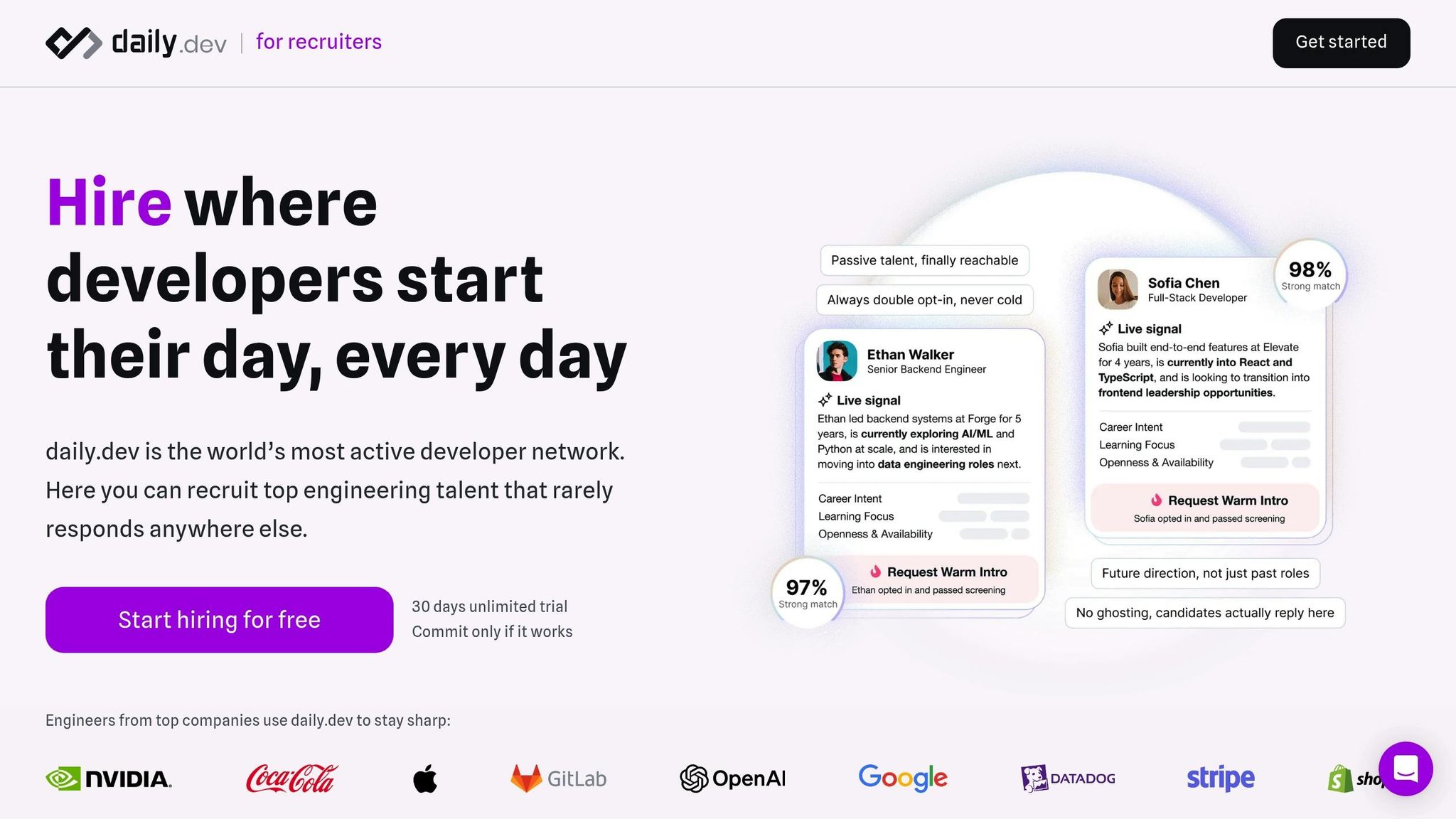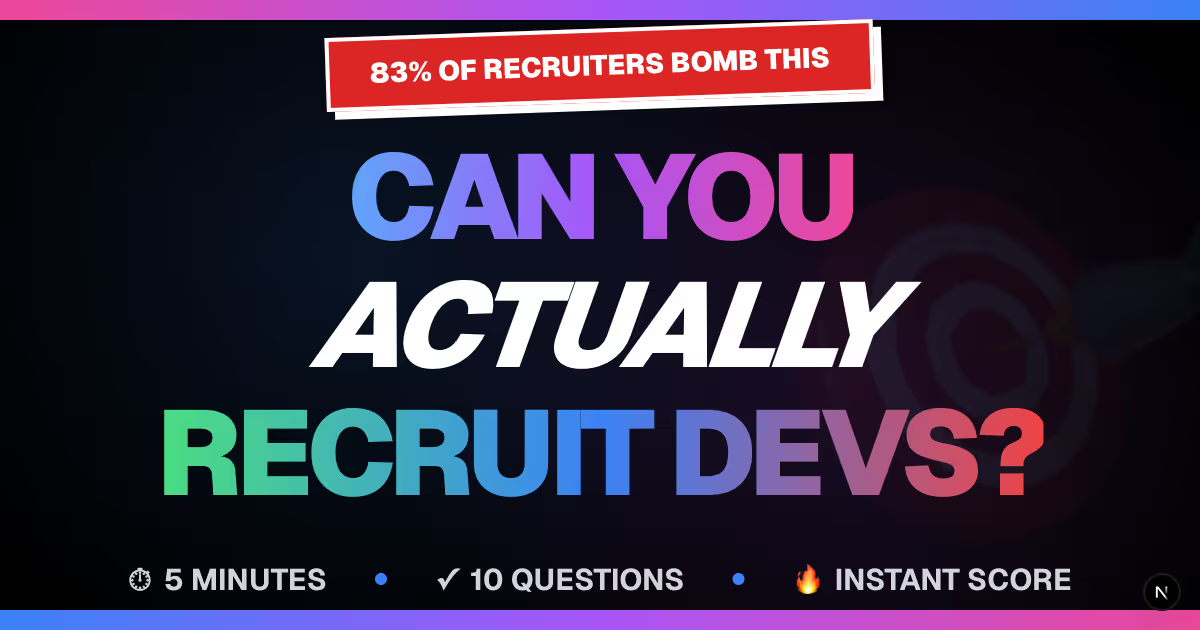


Improve your developer outreach by avoiding common pitfalls in InMail messaging, focusing on personalization and clarity to boost response rates.
Recruiters often fail to connect with developers because their outreach feels impersonal, generic, or irrelevant. Developers, especially passive candidates, expect concise, tailored communication that respects their time and expertise. Common mistakes include:
- Using generic templates: Messages with vague phrases like "exciting opportunities" or broken personalization tokens erode trust.
- Lack of research: Misaligned roles or ignoring recent career moves show carelessness.
- Ignoring preferences: Over-following up, avoiding salary details, or using buzzwords can alienate developers.
To improve response rates, focus on personalization, clear communication, and concise messaging. Highlight details like compensation, role expectations, and the tech stack upfront. Tools like daily.dev Recruiter address these issues by using a double opt-in system, ensuring both parties are genuinely interested before connecting.
4 Easy InMail Hacks to Get More Candidate Responses!
Common Mistakes in Developer InMail Outreach
When reaching out to developers, certain mistakes can immediately turn them off. These missteps not only lead to disengagement but also make it harder to build trust. Let’s break down some of the most common errors recruiters make.
Lack of Personalization
One of the quickest ways to lose a developer's interest is through shallow research. Simply mentioning their company or a programming language they use doesn’t cut it. Developers can spot a generic message a mile away.
True personalization means digging deeper. It’s about understanding what they’ve worked on, the technologies they’re passionate about, and their professional aspirations. For instance, messaging a React developer about a Java role without addressing the mismatch sends a clear signal - you haven’t done your homework.
Another common pitfall is assuming all developers share the same interests. Just because someone has experience in e-commerce doesn’t mean they’ll be excited about fintech, even if the technical skills align. This kind of oversight can make your outreach feel impersonal and dismissive.
Timing also matters. Reaching out to someone who just switched roles shows you didn’t take the time to check their recent career moves. Developers notice when recruiters skip basic details like job tenure or recent updates on their profiles.
Overuse of Template Language
Relying on generic, templated messages is another major turnoff. Buzzwords and corporate jargon like “rockstar developer” or “synergistic opportunities” often come across as out of touch with the technical community. Instead of impressing developers, this language can alienate them.
The words you choose also reveal how well you understand the role. Referring to a senior engineering position as “coding all day” or describing complex system architecture as “simple programming tasks” shows a lack of insight. Developers can immediately sense when a recruiter doesn’t grasp the nature of their work.
And then there are the embarrassing mistakes, like broken personalization tokens - “Hi [FIRST_NAME]” - which scream carelessness and make your outreach feel automated and unprofessional.
Ignoring Developer Preferences
Understanding and respecting how developers prefer to communicate is just as important as personalizing your message. Some developers appreciate concise messages, while others might prefer detailed technical context. Ignoring these preferences can make your outreach feel impersonal.
Over-following up is another common mistake. Unlike other industries, bombarding developers with multiple messages in a short time frame - or continuing to reach out after they’ve ignored you - can harm your reputation. Developers often share stories about overly persistent recruiters, and these tales rarely paint a flattering picture.
Finally, salary transparency is non-negotiable. Many recruiters still avoid discussing compensation upfront, but developers expect clarity. When you dodge salary questions or omit compensation details, it raises red flags and wastes everyone’s time. Starting the conversation without this transparency can erode trust right from the beginning.
What Developers Want in Professional Outreach
When reaching out to skilled developers, keeping it concise and respectful is essential. Developers highly value their time and expertise, so your outreach should reflect that understanding.
Personalization and Relevance
Generic messages won’t cut it. Developers want to feel that you’ve taken the time to understand their unique skills and career goals. Personalization goes beyond simply mentioning their current job title or the fact that they work with Python. Instead, it’s about connecting their specific technical experience to the challenges of the role you’re offering.
For example, if a developer has spent three years building microservices architecture at a fintech startup, highlight how your role allows them to apply that expertise. Similarly, acknowledging contributions to open-source projects or conference speaking engagements shows you see them as more than just their day job.
Relevance is non-negotiable. Developers get frustrated when approached about roles that don’t align with their expertise. A senior backend engineer with five years of experience in distributed systems doesn’t want to be pitched a junior frontend position, no matter how appealing the company culture might be. Tailoring your outreach to their technical background and career stage is crucial.
Clear Communication and Trust
Once you’ve personalized your message, clarity and transparency are key to building trust. Developers want straightforward information about compensation, role expectations, and company culture. Being vague about salary ranges or job requirements can come across as dishonest or unprepared.
Be upfront about compensation. For instance, instead of saying "competitive salary", specify something like "$120,000–$140,000 base salary plus equity and benefits." Developers often research market rates, and ambiguous phrases can make your outreach seem evasive.
Clarity about the role is just as important. Developers want to know exactly what they’ll be doing - whether it’s building new features, maintaining legacy systems, or leading technical projects. Include details about the tech stack, team structure, and growth opportunities. Phrases like "exciting projects" without specifics can make it seem like you don’t understand the role’s technical demands.
When describing company culture, avoid buzzwords. Instead, paint a clear picture. For example, explain if developers have autonomy in decision-making, how the team handles code reviews, or what processes are in place to manage technical debt. These specifics help developers determine if they’ll fit into your team.
Brief Messages That Respect Time
Developers appreciate messages that are short and to the point. Long-winded or overly formal messages often get ignored.
The best outreach follows a simple structure: a brief personal connection, a clear summary of the role, key details (especially compensation), and an easy next step. This approach respects their time while providing the information they need to decide if they’re interested.
Be direct. Avoid corporate jargon like "We’re seeking a rockstar developer to join our dynamic team." Instead, say something like, "We’re looking for a senior Python developer to lead API development for our healthcare platform." This kind of language immediately communicates whether the role is a good fit for their skills and interests.
sbb-itb-d1e6221
How to Fix Your InMails
Sharing salary details right from the start can significantly boost your response rates. Why? Because being upfront about compensation builds trust and aligns with what candidates care about most. Let’s dive into why this matters and how it can reshape your outreach.
Include Salary Information Upfront
The numbers back it up: LinkedIn’s 2023 Future of Recruiting report highlights that candidates place a high value on clear compensation details - this includes base salary, bonuses, equity, and benefits.
When you write your message, avoid vague terms like "competitive salary." Instead, provide specific numbers or ranges. This kind of clarity shows transparency, respects candidates’ time, and signals that you understand their priorities. It’s a simple way to make your outreach more effective and trustworthy.
How daily.dev Recruiter Solves the InMail Problem

daily.dev Recruiter takes a fresh approach to solving the challenges of traditional InMail outreach by focusing on targeted, mutual-interest connections. Unlike the cold, impersonal nature of many recruitment messages, this platform introduces a trust-based system that prioritizes meaningful engagement.
Warm, Double Opt-In Introductions
At the heart of daily.dev Recruiter’s approach is its double opt-in system. Instead of sending unsolicited messages, this method ensures that both recruiters and developers actively choose to connect before any conversation begins. This means every interaction starts with mutual interest and intent.
Developers can specify their preferences, such as job roles, technologies, salary expectations, and work arrangements. They opt in to hear about opportunities that match these criteria. On the other side, recruiters know they’re reaching out to candidates who are genuinely open to new roles. This system not only saves time but also leads to significantly higher response rates, as developers are pre-qualified and ready to engage.
Developer-Friendly Job Briefs
daily.dev Recruiter changes the game with job briefs that focus on what developers care about most. Forget the jargon-filled, generic postings - these briefs are concise, clear, and packed with the details that matter.
Here’s an example of what a developer-friendly brief might look like:
"Senior Backend Engineer | $160,000–$180,000/year | Remote (U.S. only) | Tech: Node.js, AWS, PostgreSQL | Join a 10-person engineering team building scalable fintech APIs. Flexible hours, 401(k) with match, and a focus on code quality."
This format respects U.S. salary conventions and highlights key information like technologies, team size, and benefits. It allows developers to quickly determine if a role aligns with their goals, making the recruitment process more efficient and appealing.
Integration with U.S.-Based Hiring Tools
To make things even smoother, daily.dev Recruiter integrates seamlessly with U.S. applicant tracking systems and sourcing tools, ensuring all data is formatted to local standards. Dates follow the MM/DD/YYYY format, times use the 12-hour AM/PM system, and numbers are presented with commas and periods as per U.S. conventions.
This integration eliminates the need for manual adjustments and ensures consistency across your hiring tools. When a developer shows interest, their information flows directly into your system, ready to be managed without extra work. This streamlined process not only saves time but also keeps everything organized and tailored to U.S. hiring practices.
Building Trust with Developers Through Better InMails
Once you've nailed tailored messaging and clear communication, the next step is earning trust. Trustworthy InMails can open the door to meaningful conversations.
daily.dev Recruiter takes a thoughtful approach to trust-building with its double opt-in system. This system ensures that conversations only begin when candidates have shown genuine interest. By pre-qualifying candidates and confirming their willingness to connect, the platform creates a comfortable space where recruiters and developers can engage without pressure or uncertainty. It’s a win-win for fostering authentic connections.
FAQs
How can recruiters create personalized InMail messages that developers will respond to?
To write personalized InMail messages that truly connect with developers, focus on relevance and authenticity. Begin with a subject line that stands out - maybe something tied to a shared interest or a unique detail from their profile. This small touch can immediately grab their attention.
In the body of your message, be specific about why you're reaching out. Mention the skills, projects, or achievements that caught your eye. Adding a personal note, like referencing a blog post they authored or an interesting hobby they have, shows you've taken the time to know them beyond their resume.
Make sure to clearly explain the value you're offering. How does this opportunity align with their career goals or passions? Developers value honesty and genuine interest, so ditch generic templates and craft each message with care. When personalized thoughtfully, InMails can not only build trust but also boost your chances of getting a response.
What mistakes do recruiters often make when contacting developers, and how can they improve their outreach?
Recruiters often miss the mark with developers by making easily avoidable mistakes. Sending generic, impersonal messages, using unclear or dull subject lines, or drafting long, overwhelming InMails are some of the biggest culprits. Another misstep? Not following up, which can mean losing out on valuable connections.
To step up their outreach game, recruiters should focus on personalization - mention something specific from the developer’s profile or recent achievements. Messages should also be short and to the point, with subject lines that immediately catch the eye. And don’t underestimate the power of a thoughtful follow-up - it can make all the difference in building trust and earning a response from tech professionals.
Why should you include salary details upfront in InMail messages, and how does it affect response rates?
Including salary details right away in your InMail messages shows respect for the recipient's time and demonstrates openness. For developers - and most professionals - clear, direct communication matters, and salary often plays a big role in their decision-making. By addressing this upfront, you signal that you understand their priorities and are serious about the opportunity.
This simple step can make a big difference in response rates. It helps establish trust and eliminates unnecessary back-and-forth. When candidates know what’s on the table, they’re more likely to engage and can quickly decide if the role fits their expectations and career goals.
Related Blog Posts








